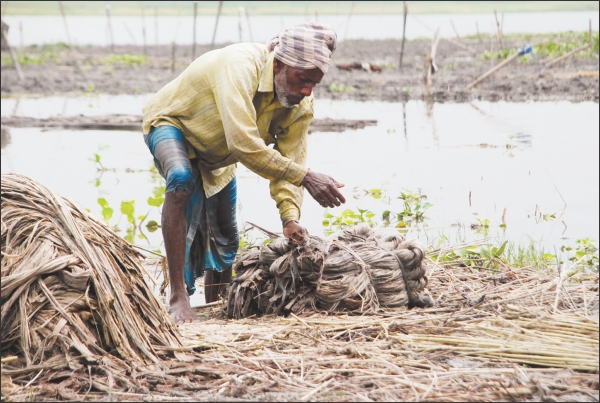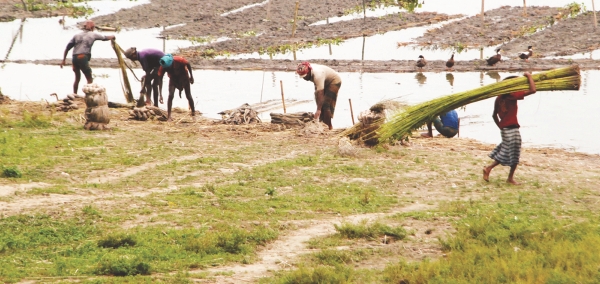Farmers’s Voice
Return of the Golden Fibre
Damurhuda upazila in Chuadanga is an agriculturally enriched region. Farmers cultivate almost all kinds of crops there. Traditionally, the region cultivates jute since an early period of time. The international price increased recently and farmers are coming back to jute farming. Though farmers got good price in last two years, but there are some extreme price variations, which are causing problems for them.
.................................................................................................
Shykh Seraj
 In all around the southern region of Bangladesh, jute is being cultivated this year higher than the previous seasons. Due to lack of rainfall and nature's adverse approach, in many areas, farmers couldn't sow jute seeds. Still, using motorized irrigation to sow their seeds farmers didn't miss the opportunity. Looking at their eventful activities, it seems that the golden days of jute have returned. In all around the southern region of Bangladesh, jute is being cultivated this year higher than the previous seasons. Due to lack of rainfall and nature's adverse approach, in many areas, farmers couldn't sow jute seeds. Still, using motorized irrigation to sow their seeds farmers didn't miss the opportunity. Looking at their eventful activities, it seems that the golden days of jute have returned.
According to the agriculture department, the target jute cultivation in Bangladesh was on 7.5 lakh hectares. The yield was targeted at 8 million bales. Both the cultivation area and yield amount is way more than the previous year. Khulna division alone, the target yield was around 1,15,096 hectares in ten districts of the division. 287 hectares of land were dedicated for the local varieties and 1,14,818 hectares of land for the Tosha variety. But, farmers simply doubled this number and went on with their cultivation.
The region has this year cultivated on 2,07,180 hectares. On 1,131 hectares, local variety was cultivated and on 2,05, 936 hectares, the Tosha variety.
In Chuadanga district, it was cultivated on double area than targeted. The target was to cultivate on 10,740 hectares, however, farmers cultivated on 24,600 hectares. Farmers say though the cultivation area is increasing, the price is not. Asking Tajer Ali, a farmer from Damurhuda's Raisa wetland area, how is the jute farming going this year;
“Somewhat, better”, he replied.
“The price?”
“900 taka per maund.”
“So, the price is quite okay?”
“If it was 1000 taka, we could have survived somehow.”
I came to know from Tajer that the production cost, per maund. He said that the transport cost for each bundle costs three takas. If he sends 300 bundles, the transport cost alone, stands at 900 taka. He employs tweleve labours during the harvest time and for also doing the bundling.
I also talked with some other farmers regarding the profit and loss accounts of jute farming.
“How many maunds did you sell?”
“Seven.”
“What was the price?”
“Per maund, 850 taka.”
They couldn't exactly tell about the production cost, because they don't even know! One farmer said he recruited three labours at 170 taka, for each man. Three times the weeds have to be cleaned on three different days. Then comes other costs for harvesting, bundling, carrying. I wondered what exactly their production cost is because how would they figure out their profit or loss after final sell.
“If you don't calculate, how would you figure out your profit, or even, your loss”, I asked.
“Our stomachs will stay empty, if we go for the calculations”, replied the dejected farmer. For peeling thirty jute bundles, farmers need one labour. A whole day goes behind peeling those thirty jute bundles.

Another problem was identified – though the cultivation has increased in the region, but the quality of jutes fell quite abruptly. Though the wetland has enough water, rotting should not be a big deal, however, farmers can't keep up the quality. For keeping the bundles under water, they are using muddy soil. This is why the jute is losing its original colour and of course, the quality.
The jutes look blackish, because of the mud. Without using mud, they can't keep the jutes under water. I recommended them a technology which can bring back the golden colour. I have seen farmers of Dhamrai are following this method. They used straws over the jutes, and used water. The jutes turned golden in a very simple way. Department of Agriculture has prohibited the rotting of jutes using mud or banana trees, but options are still under discussion and the problem still remains unresolved.
Farmers across the country are suffering hugely, rotting jutes. As there is insufficient rainfall during the rainy season, rivers and canals, thus doesn't have much water. At the northern districts of Bangladesh, as the canals dried out, farmers faces severe crisis, rotting jutes. Though initiatives were taken to increase the usage of an advanced government-introduced jute rotting technology, called, 'Ribbon Retting', in reality, at farm level, the technology was a flop. Moreover, farmers are not even aware of this technology in many parts of Bangladesh. Farmers expressed directly why they are still unaware of 'Ribbon Retting'.
 “We don't get any extension officers at fields who would suggest us how we can best rot our jutes…how it would be more cost effective.” “We don't get any extension officers at fields who would suggest us how we can best rot our jutes…how it would be more cost effective.”
In most of the areas of Bangladesh, labour demand rises in works like peeling jute fibre and washing them afterwards. Many marginal farmers and agro-labours get involved in this work. I found some labours washing jute plants. I had a talk with a woman labour there.
“If I take ten bundles for peeling, I keep the half with me and return the landowner five bundles”, she said. Apart from peeling jute fibres, she doesn't have any other works to do. She continues doing it, years after years.
Jute is a crop that can make multi-purpose profits. For example, jute sticks can be one great by-product. Farmers say that they are making good profit from the jute sticks. They're also using it as biomass fuel. Per bundle price is Tk. 30.
“How many bundles of jute you produce on one bigha land”, I asked a farmer.
“We get 100 bundles of jute sticks”, the farmer replied. So, there is an extra Tk. 2000 to 3000 income.
In different districts and regions of Bangladesh, many farmers got involved with jute farming. Still, the total yield is not impressive. Farmers should be able to yield at least thirteen maunds, per bigha. Seeds they buy have catchy brand messages, 'Low production cost, high yield' etc. After the harvest, the calculation doesn't match with the brand lines anymore. Farmers get poor seeds and unfriendly markets…thus they are cheated, most of the times. We should be able to provide farmers quality seeds. BADC can assist farmers to double the production providing them with quality jute seeds at farm level.
Last season, farmers got a good price. Starting from 1000 taka per maund, they sold at 2500 taka per maund in some parts of Bangladesh. In 2010, farmers also got a good price.
The price has boosted other farmers to go for jute farming. However, many farmers also got frustrated looking at the price they are getting this year. The price is not that good this year. I learned about farmers' frustration, visiting them in Meherpur.

“My cost was 8000 taka on one bigha land. I got only five thousand taka in return. We will not cultivate jute in future”, an angry farmer reacted. So, I could finally guess, on one bigha land, the production cost goes up to eight thousand taka!
Even the middlemen are not making profits. They are also not feeling comfortable this year, though the cultivation area has increased.
“It's becoming a great problem for us when we go the fields to buy jutes. The price is quite poor at the market. The colour is not good. We can't make good profits at all. The price is varying like anything”, said one wholesaler.
Demand of jute has increased at the global market. As the demand increases, the price has also jumped. Government has taken plans to utilize the prospects of jute in Bangladesh. For the development of the sector, government is restarting the already closed jute mills and installing new machineries there. Government has undertaken a 1300 crore taka project, targeting the development of jute industry. However, there is merely any research going on in terms of promoting diversified jute products.
The reality is, farmers are not getting good price at all. Looking at the diverse undertakings at the policy level, farmers increased jute farming. But, if they are hit back with frustration, the golden days of jute fibre will be pushed back to the walls, yet again. I firmly believe, government will take effective initiative which will ensure fair price for the farmers, which will inspire them more and would help them make a good satisfactory profit.

Copyright
(R) thedailystar.net 2012 |

 I
I
 “We don't get any extension officers at fields who would suggest us how we can best rot our jutes…how it would be more cost effective.”
“We don't get any extension officers at fields who would suggest us how we can best rot our jutes…how it would be more cost effective.” 
